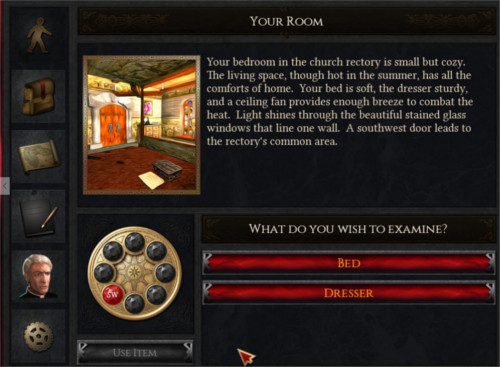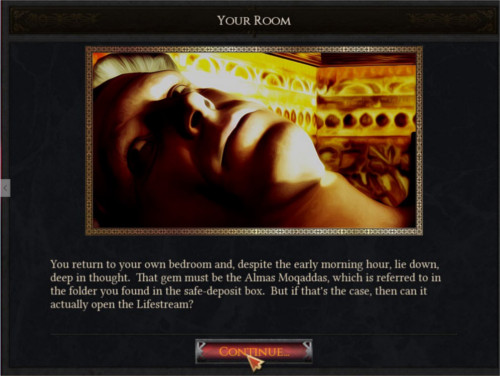
Lifestream – A Haunting Text Adventure Review
I would encourage fans of text adventures and story-driven games to give Lifestream a whirl
Category: Review
Written by: Cindy Kyser on September 24, 2016
Developed by: Unimatrix Productions
Published by: Storycentric Worlds
Platform: Windows, iOS, Android
Genre: Adventure (Mature)
Release date: June 2016
Last month, I reviewed Shady Brook – a story-driven adventure developed by Unimatrix Productions using its Storycentric game engine. In that review I described their strategic approach to furthering the genre of text adventures and showcasing the interactive interface they’d developed. To summarize, Unimatrix has developed a user friendly point-and-click interface as a presentation layer for the text adventure. The Storycentric model also provides a toolkit that shortens the process of moving from story to game and allows the writer/developer to focus on narrative rather than technology.
This month, I’ve had the pleasure of playing Lifestream – a second title by Unimatrix. In 2004, this game was released as a graphic adventure. As is he case wih Shady Brook, it’s been reworked and republished in the new Storycentric format. While the basic plot of Lifestream remains the same as in the original version, the story has been expanded to include additional background information.
The Lifestream story is told from the first person viewpoint of two primary characters. John Holton is the illegitimate son of Randolph Holton, a catholic priest. To protect Randolph’s reputation, John has kept their relationship at arm’s length. However, he becomes concerned when he loses all contact with his father. He travels to Randolph’s home and begins searching for clues that might lead to the missing priest. He finds personal journal pages among his father’s belongings which segue to game segments played from Randolph’s perspective.
While John’s exploring his father’s house in the present, Randolph is solving a separate mystery in the past. Each character has his own locations to explore, his own inventory to manage, and his own puzzles to solve. Ultimately, their stories intersect in a very surprising way. I hesitate to reveal any more of the storyline, as the surprise ending is part of what makes Lifestream such a satisfying adventure.
For players who are paying attention, there’s at least one reference to Shady Brook in the Lifestream narrative. Unimatrix has promised that players who play future titles will continue to see crossovers in terms of characters and plots.
Using a common interface to tell different tales is a real win for gamers who enjoy story-driven adventures. Once you’ve played one Storycentric title, the next is effortless because you already understand game mechanics. Thus, you’re free to enjoy the storytelling rather than going through a learning curve to master a new interface.
Narrative is presented in a main panel with a combination of text and illustrations. Icons appear along the left side of the screen to access inventory, a map, notes, and objectives. Movement between scenes requires clicking on the compass, which highlights all directions that are accessible. Instead of typing ‘examine book,’ actions are listed in the lower portion of the screen and are executed with a click.

In some cases, your action leads to additional narrative that can be likened to a cut scene in a traditional graphic adventure. These are presented as illustrated blocks of story which are clicked through to continue.

While you’re playing, the story is enhanced by an audio track of music and environmental sounds. There are no voice-overs to distract you from reading all text at your own pace.
Puzzles are presented as real life tasks such as accessing a blocked area, distracting another character, preparing a potion according to directions, and identifying clues needed to navigating maze-like areas. Decisions are made by selecting from various options on the screen to answer the question’,”What do you want to do next?” In some cases you need to use an inventory item which is made active by clicking. Inventory items can be combined (such as using matches and a candle to create a lit candle) by clicking on one and then the other. All-in-all it’s a simple interface that’s very intuitive.
Having played both Lifestream and Shady Brook, my sense is that Unimatrix is creating a story-driven experience that falls inbetween reading a novel and playing a traditional adventure. Those of us who are drawn to narrative will appreciate the common interface while becoming fully involved in the story. For those new to the Storycentric approach, an in-depth tutorial is available when you start the game to answer any interface questions you might have.
I love to read. However, my book list is shrinking because I have a terrible habit of falling asleep after just a few pages. Not because a book is boring. Rather, because my days are long and I live in a state of moderate sleep deprivation. For me, life is simply too short to lose 8+ hours to sleep! I share this because it’s part of why a game such as Lifestream is perfect for me. I get to experience a good story while keeping my mind engaged. By actively participating in the drama and driving character direction, I’m energized while reading.
I would encourage fans of text adventures and story-driven games to give Lifestream a whirl. It recently became available on Steam and has a low price point. In terms of the story, I actually enjoyed it more than Shady Brook. It has less travel between locations in search of other characters, and the story is more complex. Switching between characters (John and Randolph) keeps you on your toes as you manage two separate quests and follow two different plot lines. For me, the ending of Lifestream was totally unexpected. With 20/20 hindsight, there were a couple of flashbacks that alluded to the direction the story would ultimately take, but I didn’t put the puzzle pieces together until the very end.
Grade: B+
|
+ A simplified interface will appeal to text adventurers who hate typing and doing battle with a parser.
+ Well-written story with an unexpected ending. + Low price, coupled with tablet availability, makes this worth a try for those who are not already game enthusiasts. A full tutorial is provided for newcomers.
– Players who prefer to do more and read less may not appreciate this title.
– Still artwork may not appeal to those seeking a more visually immersive experience
|
 |
Trailer:
MINIMUM:
OS: Windows XP
Processor: Pentium 4
Memory: 2 GB RAM
Graphics: any
DirectX: Version 9.0
Storage: 65 MB available space
Sound Card: optional but recommended
Additional Notes: Native resolution: 1366×768; rescales to fill screen
Leave a Reply